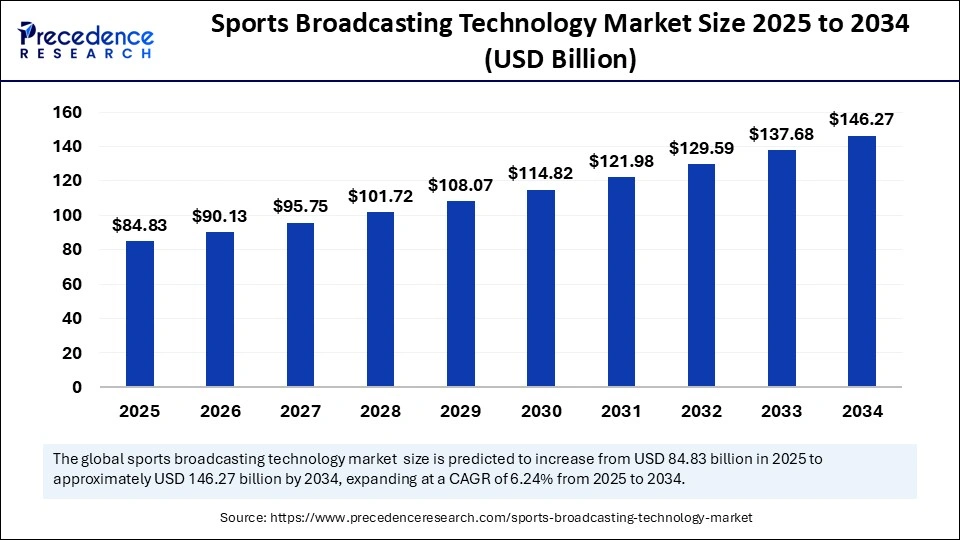
Sports Broadcasting Technology Market Key Takeaways
- North America dominated the sports broadcasting technology market with the largest share of 37% in 2024.
- Asia Pacific is projected to host the fastest-growing market in the coming years.
- Europe is anticipated to witness notable growth in the global market.
- By component, the solutions segment led the global market in 2024.
- By component, the services segment is projected to expand rapidly in the coming years.
- By technology, the digital segment held a biggest market share of 78% in 2024.
- By technology, the analog segment is expected to grow rapidly during the forecast period of 2025 to 2034.
- By platform, the television segment dominated the global market in 2024.
- By platform, the OTT platform segment is projected to grow at the fastest CAGR in the future years.
- By end-use, the broadcasters segment led the global market in 2024.
Market Overview
The sports broadcasting technology market is undergoing rapid transformation as consumer demand for immersive and interactive viewing experiences grows. The proliferation of digital platforms, increasing popularity of live streaming, and advancements in high-definition and 4K/8K broadcasting technologies are reshaping how sports content is delivered and consumed globally. Technologies such as augmented reality (AR), virtual reality (VR), and artificial intelligence (AI) are increasingly integrated into broadcasting systems to enhance storytelling and audience engagement. Broadcasters and technology providers are heavily investing in innovative solutions to meet the changing preferences of viewers, resulting in a dynamic and competitive market landscape.
Drivers
The primary drivers of the sports broadcasting technology market include the surging demand for real-time sports coverage across multiple devices and platforms. The rise of smart TVs, mobile streaming apps, and over-the-top (OTT) services has drastically altered traditional broadcasting models. Technological advancements in camera equipment, real-time analytics, and cloud-based broadcasting solutions are empowering networks to deliver superior quality content more efficiently. Furthermore, the increasing demand for customized content and the integration of AI-driven analytics for personalized viewing experiences are driving the adoption of new broadcasting technologies across the sports sector.
Opportunities
There are substantial opportunities emerging in the sports broadcasting technology market as leagues and broadcasters explore new revenue streams. The growing popularity of eSports and virtual sports events is opening up new avenues for technology providers. The adoption of blockchain technology for content protection and rights management offers another area of opportunity. Additionally, the expansion of 5G networks will allow for ultra-low latency streaming and augmented in-stadium experiences, further enhancing the scope for innovation. Emerging markets, particularly in Asia-Pacific, Africa, and Latin America, present untapped potential as internet penetration and mobile device usage continue to rise.
Challenges
Despite its growth potential, the sports broadcasting technology market faces several challenges. High production and technology upgrade costs can be prohibitive, especially for smaller networks and emerging leagues. Piracy and illegal streaming of live sports events pose significant threats to revenue generation and content security. Furthermore, the need to ensure seamless and uninterrupted viewing experiences across different devices and networks requires robust infrastructure and poses technical challenges. Regulatory compliance and the complexity of negotiating broadcast rights across international markets also add layers of difficulty for industry stakeholders.
Regional Insights
North America dominates the sports broadcasting technology market, largely due to the presence of major sports leagues and a mature digital infrastructure. Europe follows closely, with significant investments in sports technology and an increasing trend towards immersive viewing experiences. The Asia-Pacific region is expected to witness the fastest growth, driven by the booming popularity of sports like cricket, soccer, and eSports, along with rapid technological adoption in countries such as China, India, and South Korea. Latin America and the Middle East are emerging as promising markets as sporting culture and digital consumption patterns evolve rapidly.
Recent Developments
Recent developments in the sports broadcasting technology market include the increasing use of AI for automated highlights generation and real-time game analysis. Broadcasters are experimenting with VR-based experiences, allowing fans to virtually attend live events. Companies are also investing in remote production capabilities to reduce costs and enhance flexibility. Partnerships between tech firms and sports organizations are becoming more common, focusing on innovations like drone camera coverage and 360-degree replays. The introduction of direct-to-consumer streaming services by major sports leagues is reshaping traditional broadcast models, further intensifying competition.
Sports Broadcasting Technology Market Companies
- Broadcast Electronics (Elenos S.r.L.),
- IBM Corporation
- Staige GmbH
- Rohde and Schwarz
- AvL Technologies
- OMB Broadcast
- Global Invacom
- Hangzhou HAOXUN Technologies Co., Ltd.
- ETL System Ltd.
- NEC Corporation
- VSN Video Stream Networks S.L.
- Sportradar AG
Segments Covered in the Report
By Component
- Solutions
- Software
- Hardware
- Dish Antennas
- Amplifiers
- Switches
- Encoders
- Video Servers
- Transmitters/Repeaters
- Modulators
- Others
- Services
By Technology
- Analog
- Digital
By Platform
- OTT
- Radio
- Television
- Satellite Direct-to-Home
- Digital Terrestrial Television (DTT)
- Cable Television
- IPTV
By End-User
- Broadcaster
- Studios and Content Developer
- Distributors
By Region
- North America
- Asia Pacific
- Europe
- Latin America
- Middle East and Africa
